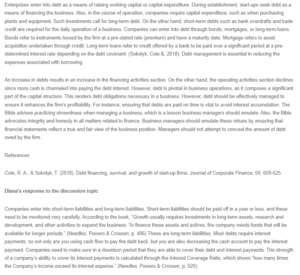Discussion Response – Debt Obligations
Diana,
Great job with your post! I agree with you that there exist two types of debts: long-term and current debts. The former constitute long-term loans, bonds, and mortgages, and the latter entails overdraft and trade creditors. Growth requires long-term investment from companies in the form of asset acquisition, research, and development, among others (Coleman, Cotei, & Farhat, 2016). I would like to add that these investments comprise capital expenditure that demands significant financial resources that are raised from external sources, such as bonds.
Debt obligations reduce operational working capital through interest payment and paying back the principal. Subsequently, firms should wisely select the capital projects they invest in so that the cash flows yielded are sufficient to repay the debt. If not, firms may end up using profits to repay their debts, resulting in financial distress (Pianeselli & Zaghini, 2014). As mentioned, the interest coverage ratio is a great tool in assessing a company’s debt position. This ratio determines the number of times a company’s income exceeds the interest expense.
Companies ensure they repay debt interest and principal during downturn periods. I would like to add that, recession constitutes the macro environment over which the organization has no control. I would recommend companies to avoid debt when such periods are looming. Such periods entail declines in business profitability due to a decrease in customer purchasing power (Pianeselli & Zaghini, 2014). Hence, long term projects would be less profitable during these economic periods.
As mentioned, debt is unavoidable since situations requiring significant financing will always arise. Moreover, debt can be manipulated as a lever in enhancing the enterprises’ growth. Nonetheless, businesses should ensure all debts are paid within the shortest period, for as the Bible states, “Let no debt remain outstanding” (Romans 13:8, ESV).
References
Pianeselli, D., & Zaghini, A. (2014). The cost of firms’ debt financing and the global financial crisis. Finance Research Letters, 11(2), 74-83.
The Holy Bible NLT. (1996). Wheaton Ill: Tyndale House Publishers Inc.
Coleman, S., Cotei, C., & Farhat, J. (2016). The debt-equity financing decisions of US startup firms. Journal of Economics and Finance, 40(1), 105-126.
ORDER A PLAGIARISM-FREE PAPER HERE
We’ll write everything from scratch
Question

Discussion Response – Debt obligations
Enterprises enter into debt as a means of raising working capital or capital expenditure. During establishment, start-ups seek debt as a means of financing the business. Also, in the course of operation, companies require capital expenditure, such as when purchasing plants and equipment. Such investments call for long-term debt. On the other hand, short-term debts such as bank overdrafts and trade credit are required for the daily operation of a business. Companies can enter into debt through bonds, mortgages, or long-term loans. Bonds refer to instruments issued by the firm at a pre-stated rate (premium) and have a maturity date. Mortgage refers to asset acquisition undertaken through credit. Long-term loans refer to credit offered by a bank to be paid over a significant period at a pre-determined interest rate depending on the debt covenant (Sokolyk, Cole &, 2018). Debt management is essential in reducing the expenses associated with borrowing.
An increase in debts results in an increase in the financing activities section. On the other hand, the operating activities section declines since more cash is channeled into paying the debt interest. However, debt is pivotal in business operations, as it composes a significant part of the capital structure. This renders debt obligations necessary in a business. However, debt should be effectively managed to ensure it enhances the firm’s profitability. For instance, ensuring that debts are paid on time is vital to avoid interest accumulation. The Bible advises practicing shrewdness when managing a business, which is a lesson business managers should emulate. Also, the Bible advocates integrity and honesty in all matters related to finance. Business managers should emulate these virtues by ensuring that financial statements reflect a true and fair view of the business position. Managers should not attempt to conceal the amount of debt owed by the firm.
References
Cole, R. A., & Sokolyk, T. (2018). Debt financing, survival, and growth of start-up firms. Journal of Corporate Finance, 50, 609-625.
Diana’s response to the discussion topic
Companies enter into short-term liabilities and long-term liabilities. Short-term liabilities should be paid off in a year or less, and these need to be monitored very carefully. According to the book, “Growth usually requires investments in long-term assets, research and development, and other activities to expand the business. To finance these assets and actives, the company needs funds that will be available for longer periods.” (Needles, Powers & Crossen, p. 486) These are long-term liabilities. Most debts require interest payments, so not only are you using cash flow to pay the debt back, but you are also decreasing the cash account to pay the interest payment. Companies need to make sure that they are able to cover their debt and interest payments during a downturn. The strength of a company’s ability to cover its interest payments is calculated through the Interest Coverage Ratio, which shows “how many times the Company’s income exceed its interest expense.” (Needles, Powers & Crossen, p. 520)
Debt is usually inevitable for most companies, similar to most individuals. Most people cannot buy a house with cash on hand, and most business owners cannot buy large buildings and equipment at start-ups with cash. I think the important ideas to keep in mind are as follows: 1. You have to pay the debt back, and 2. The debt-to-income ratio can’t be too high. Psalm 37:21 (ESV) says, “The wicked borrows but does not pay back…” The word is key. It doesn’t say the wicked barrow; it says the wicked barrows, but it does not pay back.
References:
Needles, B. E., Powers, M., & Crosson, S. V. (2014). Financial and managerial accounting (10th ed.). Mason, OH: South-Western, Cengage Learning.

